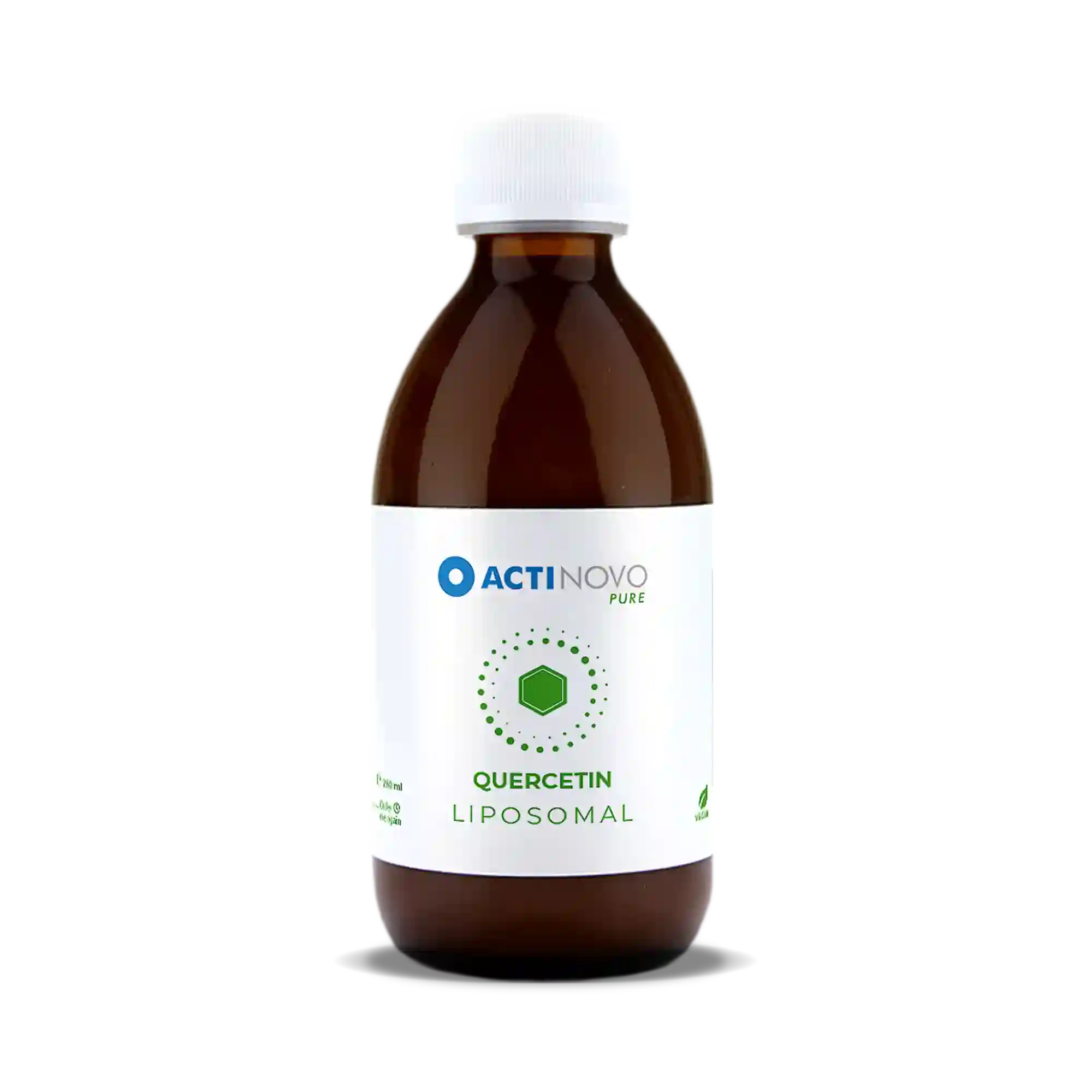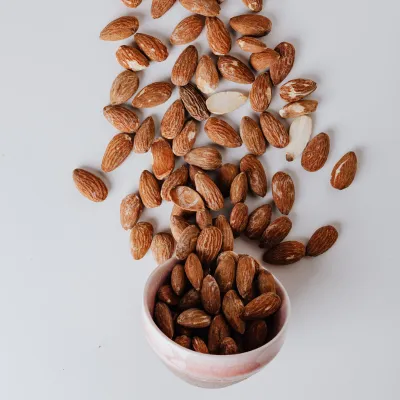
Quercetin: Your Savior in Pollen Season
What will you learn in this guide?
1. What is quercetin?
2. Quercetin Foods
3. Quercetin Absorption
4. Health Benefits of Quercetin
5. Quercetin and the Thyroid Gland
6. Quercetin levels
7. Liposomal Quercetin
1. What is Quercetin?
Quercetin is a secondary plant substance that belongs to the flavonoid group. The substance is found as a yellow colouring agent in many plant foods, such as fruit and vegetables.
The strong antioxidant properties of the plant substance are used in nature to protect against external environmental influences such as predators or damage caused by UV radiation.
In recent years, quercetin has gained more attention. Although the plant substance has only gained popularity in the last years, it is now more and more in the focus of research. Previous studies have shown that quercetin can be linked to a reduction in seasonal allergies, a strengthening of the immune system and a reduction in high blood pressure.
2. Quercetin Foods
Among the most commonly used foods, onions, asparagus, apples, blueberries, figs, kale, and cocoa have particularly high amounts of the antioxidant [1].
The amount of the substance in foods varies depending on when they are harvested and how long the foods are stored. The quercetin content in foods can also be lost with the storage time, but also depending on how they are prepared.
Most quercetin rich foods are those with an outer peel, such as the red peel of an apple. When you remove the peel of the apple, it has practically no quercetin content left.
These are some foods with Quercetin:
- Apples with peel (3.6mg/100g)
- Beans (4mg/100g)
- Watercress (30mg/100g)
- Coriander leaves (50mg/100g)
- Sorrel (85mg/100g)

3. Quercetin Absorption
The flavonoid Quercetin has promising health effects, but the challenge lies in its low bioavailability. The bioavailability of quercetin is even below 10% [2].
The levels of Quercetin in food can be influenced by various factors such as cooking methods, the addition of fats, and how fresh the foods are. Additionally, the amount of Quercetin contained can differ even among similar foods.
As a result, it's difficult to determine the exact amount of this antioxidant present in our food. Moreover, many people are struggling consuming enough foods or vegetables to ensure adequate levels of Quercetin in their bodies.
Researchers suggest that to achieve the effects observed in supplementation studies, one may need to consume 10 to 60 times the average intake of fruits and vegetables.
For example, to get 250mg of Quercetin from food (without considering absorption rate), you would have to eat 7 kilograms of apples or 2 kilograms of onions alone. Even after consuming Quercetin-rich foods, it's still unclear how much of the substance remains intact and is effectively absorbed by the body.
4. Health Benefits of Quercetin
Free Radical Scavenger
Quercetin stands out as one of the most crucial antioxidants in our diet. Its primary role involves neutralizing free radicals within the body, which are particles notorious for triggering oxidative stress, inflammation, and cell death [2].
Beyond its free radical scavenging propertoes, quercetin exerts a broad range of effects on signaling pathways in the body. These actions either activate or suppress inflammatory markers. Furthermore, it has the capacity to enhance the production of glutathione, recognized as the body's most potent antioxidant, along with other enzymes with antioxidant properties [3].
When the body effectively absorbs significant quantities of quercetin, it potentially provides added protection against inflammation and cellular damage, thereby contributing to overall health and well-being.
Quercetin for Allergies
Research suggests that quercetin has the potential to decrease the release of substances that trigger allergic reactions. Specifically, it may reduce histamine release. Histamine is the molecule that triggers the symptoms of allergies, such as stuffy nose or a cough. Thus, reducing the amount of this molecule can reduce the allergic reaction itself [4][5].
Quercetin as a natural antihistamine may help to reduce allergy symptoms.

A study conducted in Japan showed that quercetin ingestion significantly inhibited histamine release. The effect of the quercetin supplement was almost twice as beneficial as other conventional drugs for hay fever at the same concentration [6].
This antioxidant may serve as a natural remedy not only for hay fever but also for food allergies.
Animal studies have shown that administering a high dose of quercetin led to a notable reduction in histamine levels in rats allergic to peanuts. There were no adverse side effects related to the lungs, blood pressure, or blood vessels [7].
Want to learn more? Take a look at our blog article about allergies.
Quercetin and Rheumatoid Arthritis
Rheumatoid arthritis is a disease of the joints, and is frequently associated with inflammation and pain.
Quercetin, known for its anti-inflammatory and pain-relieving effects, offers promise in managing this condition. It operates through various mechanisms, including the regulation and inhibition of pathways that trigger inflammation. One of these is the inhibition of inflammatory markers called cytokines.
The mechanisms responsible for the pain-releasing effects of quercetin are not yet fully known. However, it is likely that this is also due to the antioxidant and anti-inflammatory effects of quercetin [8][9].
Clinical trials have demonstrated the substantial efficacy of quercetin in reducing inflammation and alleviating pain associated with rheumatoid arthritis.
In one study involving women with rheumatoid arthritis, quercetin administration led to significant improvements of symptoms. These improvements included morning stiffness, pain, joint tenderness, and physical function. Furthermore, quercetin supplementation resulted in reduced levels of
TNF-alpha, a key inflammatory mediator implicated in rheumatoid arthritis [10].
Quercetin and Brain Health
Recent research suggests that quercetin and mood may be related, specifically with anxiety relieving and antidepressant effects.
In rodent studies, supplementation with quercetin demonstrated a reduction in the levels of CRF (corticotropin releasing factor). CRF is a molecule in the brain commonly associated with anxiety and depression.
This reduction in CRF levels is believed to underlie the substance's anxiolytic and antidepressant effects[11].
Moreover, experiments with rats quercetin supplementation not only improved cognition, but also contributed to anxiety relieving effects [12].
Furthermore, recent studies indicate that the substance may hold promise to reduce the risk of neurodegenerative diseases like Alzheimer, thus highlighting its brader impact on brain health.
Not all mechanisms of action are completely clear, but researchers believe that the effects are due to strong antioxidant and anti-inflammatory properties [13][14].

Quercetin and Blood pressure
Quercetin exhibits potential in lowering hypertension through diverse mechanisms. One mechanism involves the ability to mitigate oxidative stress and inflammattion.
In addition, this substance may positively influence on blood vessel elasticity by improving vasodilation, which is regulated by endothelial cells. These cells form the innermost cell layer of blood vessels.
Not all mechanisms of the relationship between quercetin and blood pressure are fully understood yet. However, according to some research studies, supplementation can make a valuable contribution to blood pressure control [15][16][17].
In particular, supplementation of the antioxidant has been shown to significantly reduce systolic and diastolic blood pressure. The most beneficial results were obtained with a dose of quercetin of 500 mg per day [18].
Importantly, quercetin-induced blood pressure appears to primarily benefit individuals with elevated blood pressure. Therefore, those with normal blood pressure don't have to be concerned about experiencing a sudden decrease in levels.
In addition to the quercetin benefits on blood pressure, the substance may confer additional health benefits, such as decreasing cholesterol and triglyceride levels [19].
Quercetin and Competitive Sports
5. Quercetin and the Thyroid Gland
In experiments with mice, quercetin, along with other important antioxidants, significantly inhibits the enzyme deiodinase. This enzyme converts the hormone T4 into the active thyroid hormone T3. Such enzyme impairment can lead to hypothyroidism.
Therefore, excessive consumption of quercetin beyond the recommended daily dosage should be avoided. It is advisable for individuals with impaired thyroid function who wish to consume quercetin to consult their doctor beforehand.
6. Quercetin Levels
External supplementation is typically necessary for this antioxidant to exert significant effects [21].
An elevation in blood quercetin levels is observable with a daily intake of 150mg or more.
Side Effects
There are no adverse side effects at low doses of supplementation. [22] Quercetin side effects of thyroid function may be present only at excessive dosages. This is why it is advisable to adhere to the recommended daily quercetin dosage.
7. Liposomal Quercetin
Liposomal encapsulation is the best way to get the antioxidant where it belongs: in our bloodstream. When liposomes are ingested, they do not enter the liver where they could be broken down. Instead, the enclosed active ingredients reach their site of action directly [24].
Thanks to liposomal technology, the active ingredient is protected from harmful enzymes and gastric acid of the digestive tract.
Liposomal technology ensures almost complete absorption of the active ingredient.
Interested in learning more? Take a look at our blog article about antioxidants.




